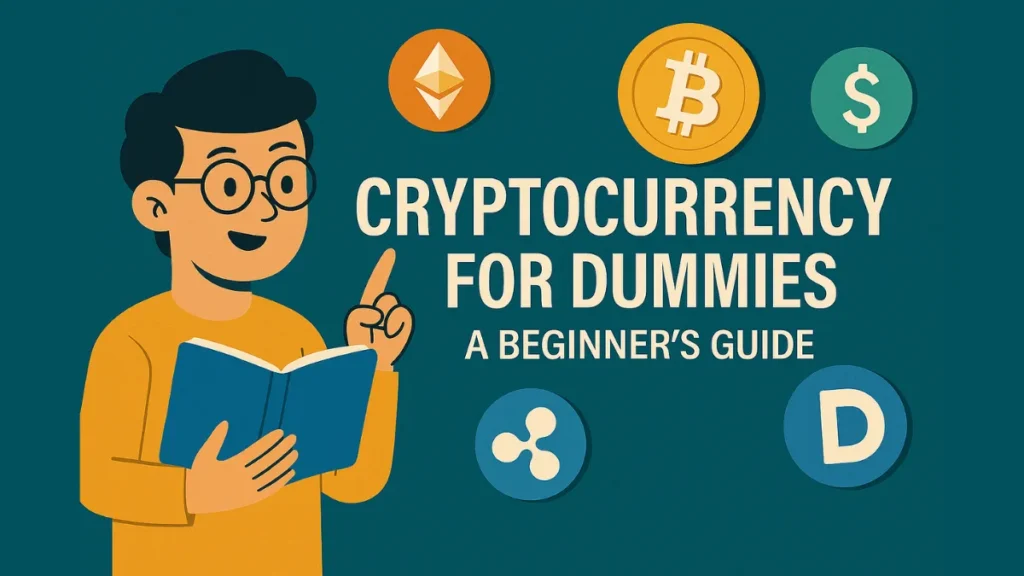Welcome to the world of cryptocurrency! Whether you’re curious about Bitcoin, Ethereum, or blockchain technology, this guide breaks down everything you need to know in simple terms. By the end, you’ll understand how digital currencies work, how to buy and store them safely, and what the future holds for this revolutionary technology.

What Is Cryptocurrency?
Cryptocurrency (or “crypto”) is digital money that operates independently of banks or governments. Unlike traditional currencies (like the U.S. dollar), crypto is decentralized, meaning no single entity controls it. Instead, transactions are verified and recorded on a blockchain—a public, tamper-proof digital ledger.
Key Features of Cryptocurrency:
- Decentralized: No central authority (like a bank) manages it. Transactions are peer-to-peer.
- Secure: Uses cryptography (advanced encryption) to prevent fraud and hacking.
- Global: Can be sent anywhere in the world with low fees, bypassing currency exchange rates.
- Transparent: All transactions are recorded on the blockchain, making them traceable but anonymous.
How Is Crypto Different from Traditional Money?
| Feature | Cryptocurrency | Traditional Currency |
|---|---|---|
| Control | Decentralized | Centralized (Banks/Govt) |
| Transaction Speed | Minutes to hours | Days for international transfers |
| Fees | Low | High for cross-border payments |
| Privacy | Pseudonymous | Linked to bank accounts |
How Does Cryptocurrency Work?
Cryptocurrencies rely on blockchain technology, which is like a digital notebook that records every transaction.
- Transactions are broadcast to a network of computers (nodes).
- Miners or validators verify transactions by solving complex math problems.
- Verified transactions are added to a “block” and linked to the previous block, forming a chain (hence “blockchain”).
Mining vs. Staking
| Method | How It Works | Energy Use | Examples |
|---|---|---|---|
| Mining (PoW) | Miners solve puzzles to validate transactions. | High | Bitcoin, Litecoin |
| Staking (PoS) | Users stake coins to validate transactions. | Low | Ethereum 2.0, Cardano |
Why does this matter?
Mining is secure but energy-intensive. Staking is more eco-friendly and considered the future of blockchain validation.
Popular Cryptocurrencies in 2025
While there are thousands of cryptocurrencies, these are the top ones for beginners:
| Cryptocurrency | Symbol | Why It’s Popular |
|---|---|---|
| Bitcoin | BTC | The original “digital gold”; limited supply. |
| Ethereum | ETH | Supports smart contracts and decentralized apps. |
| Litecoin | LTC | Faster & cheaper than Bitcoin. |
| Binance Coin | BNB | Used for trading on Binance exchange. |
| Cardano | ADA | Focuses on sustainability and academic research. |
Fun Fact: In 2010, someone paid 10,000 BTC for two pizzas—worth over $800 million today!
How to Buy & Store Crypto Safely
Step 1: Choose a Crypto Exchange
- Beginners: Coinbase, Binance, or Kraken (user-friendly).
- Advanced: KuCoin or Bybit (more trading options).
Step 2: Buy Your First Crypto
- You can buy whole coins (e.g., 1 BTC) or fractions (e.g., 0.01 BTC).
- Payment methods: Credit card, bank transfer, or PayPal.
Step 3: Store Crypto in a Wallet
| Wallet Type | Pros | Cons | Best For |
|---|---|---|---|
| Hot Wallet | Easy access for trading | Less secure (online) | Small amounts, frequent use |
| Cold Wallet | Hack-proof (offline) | Less convenient | Long-term, secure storage |
Never share your private keys! Lose them = lose your crypto forever.
Pro Tip: Use a cold wallet for storing large amounts and hot wallets for day-to-day access.
Risks & How to Avoid Scams
Biggest Risks in Crypto
- Volatility: Prices can swing ±20% in a day.
- Scams: Fake exchanges, phishing emails, Ponzi schemes.
- Regulation: Governments are still developing laws—crypto is taxed in most regions.
Safety Checklist
- Use two-factor authentication (2FA).
- Bookmark real exchange URLs.
- Store most of your crypto in a cold wallet.
The Future of Crypto Currency
Trends to Watch
- Bitcoin ETFs: Now approved—invest in BTC without owning coins directly.
- AI + Crypto: Projects like SingularityNET merge blockchain and AI.
- CBDCs: Countries are launching their own digital currencies (e.g., Digital Dollar).
- Web3 Apps: Decentralized internet platforms are gaining traction.
Will Crypto Replace Banks?
Not yet—but it’s reshaping how we store, move, and think about money.
Final Thoughts
Cryptocurrency is exciting but risky. Start small, learn the basics, and never invest blindly.
Next Steps:
- Open an account on Coinbase or Binance.
- Buy $10 of Bitcoin or Ethereum to test the waters.
- Follow crypto news on CoinDesk or Fdaytalk.com.
Start your crypto journey today!
Open a wallet, buy your first $10 in Bitcoin or Ethereum, and keep learning. Bookmark this guide or share it with a friend who’s curious about crypto!
FAQs: Cryptocurrency for Beginners
Q1. Can I start crypto investing with just $10?
Yes! You can buy a fraction of any coin. You don’t need to buy 1 full Bitcoin—just 0.001 BTC is enough.
Q2. Is crypto banned in my country?
Laws vary. In India and the USA, crypto is legal but taxed. Always check your local regulations.
Q3. What’s the difference between coins and tokens?
Coins operate on their own blockchain (e.g., Bitcoin, Ethereum). Tokens are built on existing blockchains (e.g., USDT on Ethereum).
Q4. Are NFTs and crypto the same?
NFTs are unique digital assets stored on a blockchain. They use cryptocurrency but serve different purposes.
Q5. Can I recover crypto if I lose my wallet password?
No. If you lose your private keys or seed phrase, you lose access. Always back them up securely offline.
Disclaimer: This article is for informational purposes only and does not constitute financial advice. Cryptocurrency markets are volatile. Always conduct your own research or consult a licensed advisor before investing.

